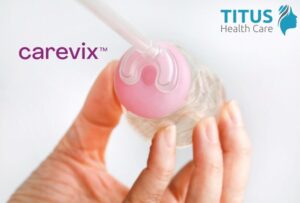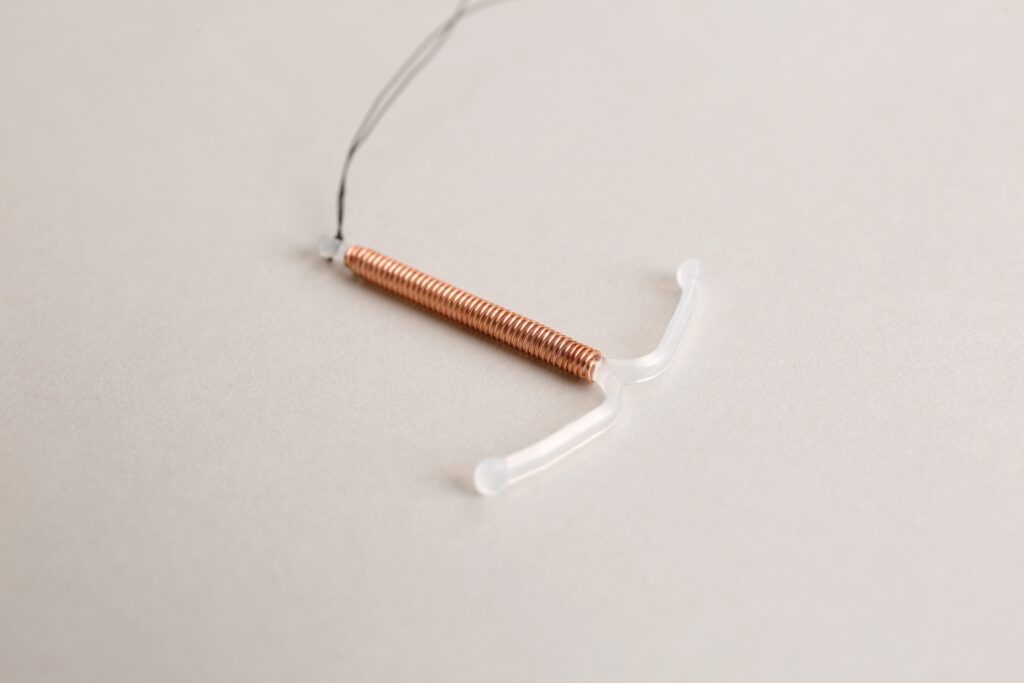TYPES OF SPIRALS
An IUD is a very reliable form of contraception that can be easily combined with breastfeeding.
There are two types of IUDs:
- The copper IUD (T-Safe)
- The hormonal IUD (Mirena and Kyleena)
We can place all types of IUD's for you at The Ultrasound Center. The advantage of this is that we check whether it fits correctly immediately after placement by means of an ultrasound.
Copper IUD T safe
A copper IUD is a hormone-free contraceptive that gradually releases a small amount of copper. Copper paralyzes sperm cells entering the uterus, rendering them inactive so fertilization cannot occur. The T-Safe copper IUD is highly reliable, hormone-free, and registered for 10 years of use. With a copper IUD, you maintain your normal menstrual cycle.
Possible side effects you may experience during the first three months after placement include:
- a longer and/or heavier menstruation,
- abdominal cramps and
- intermenstrual bleeding.
After this, the natural cycle will return. In 30% of cases, menstrual bleeding may increase slightly and lastingly. Consult the T-Safe website for an overview of the side effects.
We will arrange a prescription for the copper IUD for you at a central pharmacy. The IUD will then be delivered to our practice. This will happen after you have paid for it via a payment link from the central pharmacy. If you have supplementary insurance, the IUD will usually be covered by your health insurer. If you do not have supplementary insurance, you will have to pay for the IUD yourself.
The T-Safe IUD costs approximately €85.
Hormonal IUD Mirena/Kyleena
The hormone IUD gradually releases a small amount of hormones and ensures that the mucus in the cervix becomes 'tougher', making it more difficult for sperm cells to pass through. Due to the release of the hormone levonorgestrel in the uterus, the sperm cells become less mobile; this reduces the chance of fertilization. Due to the release of hormone and because the IUD is a "foreign object" in the uterus, the endometrium is not or hardly built up. This prevents any fertilized egg from implanting. Finally, ovulation is sometimes suppressed in some women. If no egg is released, fertilization cannot take place.
There are two different types of hormonal IUDs:
- the Mirena and
- the Kyleena.
The difference lies in the size: the Kyleena is slightly smaller and therefore releases fewer hormones and is registered for use for five years. The Mirena is often used for women with heavy periods and is registered for use for eight years. Both IUDs are equally reliable.
The difference lies in the size: the Kyleena is slightly smaller and therefore releases fewer hormones and is registered for use for five years. The Mirena is often used for women with heavy periods and is registered for use for eight years. Both IUDs are equally reliable.
- more/less blood loss during menstruation,
- intermittent bleeding or
- abdominal cramps
Absence of menstruation also occurs in some cases. Consult the package insert. Mirena or Kyleena for an overview of the side effects
We will arrange a prescription for the Mirena or Kyleena for you at a central pharmacy. The IUD will then be delivered to our practice. This will happen after you have paid for it via a payment link from the central pharmacy. If you have supplementary insurance, you will usually be eligible for reimbursement from your insurer. The Mirena or Kyleena IUD costs approximately €150.
IUD INSERTION
For the IUD placement by us at Het Echocentrum, it is important that you are certain that you are not pregnant and do not have an STD.
If this isn't the case, please contact us first. The appointment takes about 20 minutes. We'll start with an internal examination or ultrasound to check the position and size of your uterus. A speculum will be used to visualize the cervix. Then, the uterus will be measured, and the IUD can be inserted. The IUD insertion itself takes a few minutes. After insertion, an internal ultrasound will be performed to ensure the IUD is properly positioned.
Insertion can be sensitive, so we recommend taking one ibuprofen (and possibly two paracetamol tablets) about an hour beforehand. An IUD can be inserted starting 12 weeks after delivery. If you have never given birth, we prefer to insert the IUD during your period, as your cervix is slightly open at that time. This makes insertion easier. It also ensures that there is no pregnancy at that time. In all cases, we immediately check the IUD's position after insertion using an ultrasound.
It is normal to experience abdominal cramps or a nagging feeling in the lower abdomen after an IUD placement. This is usually short-lived. You may also experience irregular and/or extra bleeding and abdominal cramps during the first three months after placement.
A significant number of women are reluctant to have an IUD inserted; 18-30% of women choose not to have one due to fear of pain. 42% of women would reconsider an IUD if the insertion were less painful.
Titus Health Care has provided the following for this purpose: CAREVIX developed

Carevix is a gentle, woman-friendly alternative to forceps. This innovative device uses suction technology to grasp the cervix, which causes less pain and bleeding than traditional forceps. Carevix reduces pain, bleeding, and high satisfaction for both women and men. This increases comfort and reduces anxiety during IUD insertion, lowering the barrier for women to choose one of the most reliable contraceptive methods: an IUD.
You can indicate when you want the Carevix to be used during the placement of the IUD, but the costs for this are at your own expense.
The Carevix costs 49.95 euros
You can make an appointment for the placement of an IUD via the Ultrasound Center on the telephone number: 085-0230216
Installation costs
The costs of placing an IUD are reimbursed by almost every health insurer, even if you have the IUD placed by us.
ADVICE AFTER IUD INSTALLATION
After placement you may experience some cramps for the first few days: for these complaints you may take a maximum of 6 x 500mg paracetamol or 3 x 400mg ibuprofen per 24 hours.
- The Mirena/Kyleena Is a reliable contraceptive for 7 days after insertion. Therefore, use protection during intercourse for up to 7 days after insertion. If the IUD is inserted within 7 days of your first menstrual period, it is immediately reliable.
This IUD can cause some increased bleeding between periods for the first few months. After 3 to 6 months, your body adjusts to the IUD, and these symptoms often subside. Some women experience no bleeding at all, or only occasional bleeding, after a year or less.
- The T-safeprovides immediate protection after placement
This can cause some increased bleeding between periods for the first few months. After 3 to 6 months, your body adjusts to the IUD, and these symptoms often subside. For 30% of women, this IUD causes longer and heavier periods.
We advise against sexual intercourse for the first 2 to 3 days after insertion of the IUD (Mirena, Kyleena or T-safe). It is also best not to use tampons during the first few days after insertion. We see a higher incidence of expulsion of the IUD when using a menstrual cup. We advise against using a menstrual cup during your first menstrual period after insertion. If you use the cup afterwards, first remove the vacuum and make sure you do not grab the strings through the cup. Having us shorten the strings can be a solution.
When will you call us?
Please note that you can always call with questions up to three months after the IUD has been inserted. After that, your GP will take over your care. If the following occurs within three months of the IUD being inserted, you should contact the Ultrasound Centre. If we are unavailable, call your own GP or the GP out-of-hours service immediately.
- In case of heavy bleeding with clots and dizziness within 24 hours after placement.
- For abdominal pain that is not relieved by good pain relief (2 x 500 mg paracetamol every 4-6 hours) or 3 x 400 mg ibuprofen spread over 24 hours.
- In case of fever (temperature above 38.5 degrees Celsius), especially together with abdominal pain and changed discharge (smelly or change in color) within 21 days after placement.
- If the IUD comes out due to cramps during the first three months. (Keep the IUD!).
- In case of persistent complaints that arise after the insertion of the coil.
Check-up after 6 weeks at the practice
We offer a standard telephone follow-up appointment. During this appointment, we'll discuss your experience with the IUD and any unusual circumstances. If not, we'll assume the IUD is properly positioned in your uterus. If there are any unusual circumstances, we'll invite you to the clinic for an ultrasound to verify the IUD is properly positioned in your uterus.
A check-up at the practice can be done by a fellow ultrasound technician from our practice. The telephone follow-up check-up is a recommendation, and that's why we offer it. You don't have to take advantage of this offer. If you do want to take advantage of it, we'll schedule this check-up immediately after the placement.
You can also schedule an appointment later through our assistant. If you'd like an ultrasound without a medical reason, this is possible; we charge €25 for this.
Replacement or removal
On www.spiraalcheck.nl You can register your coil for free and you will automatically receive a message when it needs to be replaced.
The Mirena needs to be replaced after 8 years, the T-Safe after 10 years. All other IUDs are registered as contraceptives for 5 years.
If you would like to have your IUD removed or replaced (possibly before the maximum period), you can make an appointment at the practice. You'll be fertile again soon after having an IUD removed! Removal of your IUD at our practice is covered by your health insurer.


